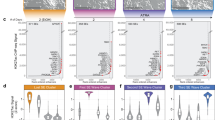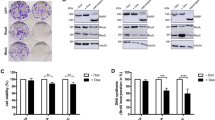Abstract
This study addresses the contributions of specific retinoid receptors during all-trans-retinoic acid (RA)-mediated differentiation and growth suppression of human embryonal carcinoma cells. The pleiotropic effects of RA are mediated by retinoic acid receptors (RARs) and retinoid X receptors (RXRs), members of the nuclear receptor family of transcription factors. After RA-treatment the multipotent human embryonal carcinoma cell line NTERA-2 clone D1 (NT2/D1) displays limited proliferative potential, reduced tumorigenicity, and morphologic and immunophenotypic neuronal maturation. RARγ over-expression in NT2/D1 cells signals mesenchymal NT2/D1 terminal differentiation while RARα and RARβ do not and RARγ overcomes retinoid resistance in an NT2/D1 clone (NT2/D1-R1) having deregulated RARγ expression. Since RARγ transfectants do not display neuronal maturation, this study sought to identify cooperating retinoid receptors engaged in NT2/D1 differentiation. Through gain of function experiments, this report highlights RXRβ as playing an important role along with RARγ in signaling differentiation of NT2/D1 cells. Stable over-expression of RXRβ, but not RXRα or RXRγ, was found to signal NT2/D1 growth suppression and to induce a non-neuronal morphology and immunophenotype. Notably, co-transfection of RARγ and RXRβ resulted in marked growth suppression and for the first time, expression of typical neuronal markers of NT2/D1 differentiation. To clarify the role of RXRβ and RARγ in this differentiation program, a modified transient fibroblast growth factor-4 (FGF4) promoter-enhancer reporter assay that reflects effective RA-mediated differentiation of NT2/D1 cells was employed. Transfection of RARγ or RXRβ in NT2/D1 cells augments transcriptional repression of the FGF4 reporter and RARγ and RXRβ co-transfection markedly repressed reporter activity, indicating the combined role of these receptors in RA-induced NT2/D1 differentiation. Taken together, these findings reveal specific retinoid receptors must cooperate to signal terminal growth suppression and maturation of NT2/D1 cells. Since the transcriptional repression of FGF4 is coupled to the effective maturation of human embryonal carcinoma cells, the described co-transfection strategy should prove useful to identify genes with positive or negative effects on the differentiation program of these tumor cells.
This is a preview of subscription content, access via your institution
Access options
Subscribe to this journal
Receive 50 print issues and online access
$259.00 per year
only $5.18 per issue
Buy this article
- Purchase on Springer Link
- Instant access to full article PDF
Prices may be subject to local taxes which are calculated during checkout
Similar content being viewed by others
Author information
Authors and Affiliations
Rights and permissions
About this article
Cite this article
Spinella, M., Kitareewan, S., Mellado, B. et al. Specific retinoid receptors cooperate to signal growth suppression and maturation of human embryonal carcinoma cells. Oncogene 16, 3471–3480 (1998). https://doi.org/10.1038/sj.onc.1201876
Received:
Revised:
Accepted:
Published:
Issue Date:
DOI: https://doi.org/10.1038/sj.onc.1201876
Keywords
This article is cited by
-
Ligand-Activated Peroxisome Proliferator-Activated Receptor β/δ Modulates Human Endometrial Cancer Cell Survival
Hormones and Cancer (2013)
-
Reversal by RARα agonist Am580 of c-Myc-induced imbalance in RARα/RARγ expression during MMTV-Myc tumorigenesis
Breast Cancer Research (2012)
-
p53 in human embryonal carcinoma: identification of a transferable, transcriptional repression domain in the N-terminal region of p53
Oncogene (2005)
-
Retinoid target genes in acute promyelocytic leukemia
Leukemia (2003)
-
Retinoids in cancer therapy and chemoprevention: promise meets resistance
Oncogene (2003)



